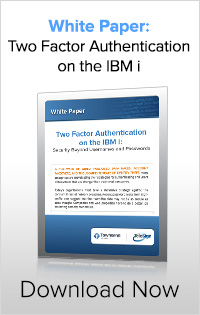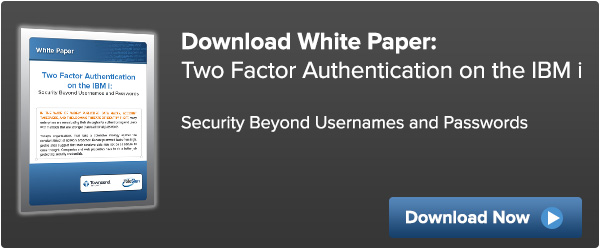Taking Security Beyond Usernames and Passwords
Security professionals understand that passwords alone are just not good enough protection, and the on-going flood of data breach reports just confirms this on a daily basis. Enterprise IBM i users aren’t going to stop using passwords to login to their IBM i platforms, and hackers aren’t going to slow the flood of attacks any time soon. But now, we can take a giant security step forward by implementing two-factor authentication (2FA) to dramatically reduce the risk of a security breach.

Compromised email, social media, online gaming, ecommerce, financial services and other types of cracked accounts continue to threaten both personal and corporate interests. Out of all the threats that face individuals and companies, account compromise stands out as one of the most easily addressed with available and mature security technologies.
Historically, companies used physical tokens to provide authentication on the IBM i beyond username and password. Even if someone hacked a user’s password, they still could not login without the physical token. Tokens represent another layer of protection, which is a step in the right direction. Unfortunately, tokens increasingly do not make fiscal sense for Enterprise IT departments who have to deploy, manage, and troubleshoot large numbers of tokens. There is a better way for organizations to quickly and cost-effectively roll out two-factor authentication to a large and sometimes global user base. Solutions that leverage the mobile phone as a reliable means of authentication have become readily available for the IBM i platform. For example, instead of tokens, businesses can simply send an SMS or voice message that contains a one-time authentication code to the individual user’s phone. This means cyber criminals cannot log into the IBM i without physical control of the actual phone.
Mobile phones and landlines present key advantages for verification and authentication regimes:
- They possess unique identifiers – phone numbers, electronic identifiers and account numbers
- They remain in the possession of users or near at hand most of the time
- They are difficult to spoof
- If stolen or otherwise misappropriated, they are easy to disable
- Their association with actual individuals is verifiable through the operators that provide phone service
While none of these attributes alone are sufficient, together they provide a compelling basis for verification and authentication. The goal is to reduce fraud and actual theft of sensitive information by implementing something much harder to defeat than a login password. Combining something the person knows with something they have, or something they are, which can then be used for two factor authentication.
1. Something you know - a password. Even “strong” passwords can still be fairly weak from an attacker's point of view. With malware that easily detects them, passwords alone are a weak defense in relation to log-in security if that's all you have.
2. Something you have - a mobile phone. It is now becoming quite common for companies to leverage what everyone already has in the way of the mobile phone or standard phone, and use that device as a mechanism for two factor authentication.
3. Something you are – biometric authentication options. Physically scanning for an iris pattern or fingerprint.
By using 2 of those 3 things you can authenticate more securely to the system.
Here are a couple examples of things that are not two factor authentication:
- Requiring two passwords: using one factor twice is not 2FA!
- Using shield questions of which are actually fairly easy in our social world to determine.
The IBM i platform has a well-earned reputation for security, but security is only as strong as the weakest point in the enterprise network. User PCs, internal and external web servers, and network applications represent points of attack. These systems are not safe from:
- Memory scraping
- Keyboard logging
- Stolen vendor credentials
- Stolen user passwords from external web services
Due to the nature and the extent of these security threats on the IBM i, two factor authentication has become a viable solution for meeting compliance regulations and safeguarding the vast amount of data and numbers of users with access to sensitive information on the IBM i. We're seeing Google, Facebook, Yahoo, and almost all large commercial banking websites implementing a two factor authentication system based on SMS text and or voice verification to give additional security to their users accounts and IBM i users now have an affordable solution for their platform. Find out more by downloading this white paper:

